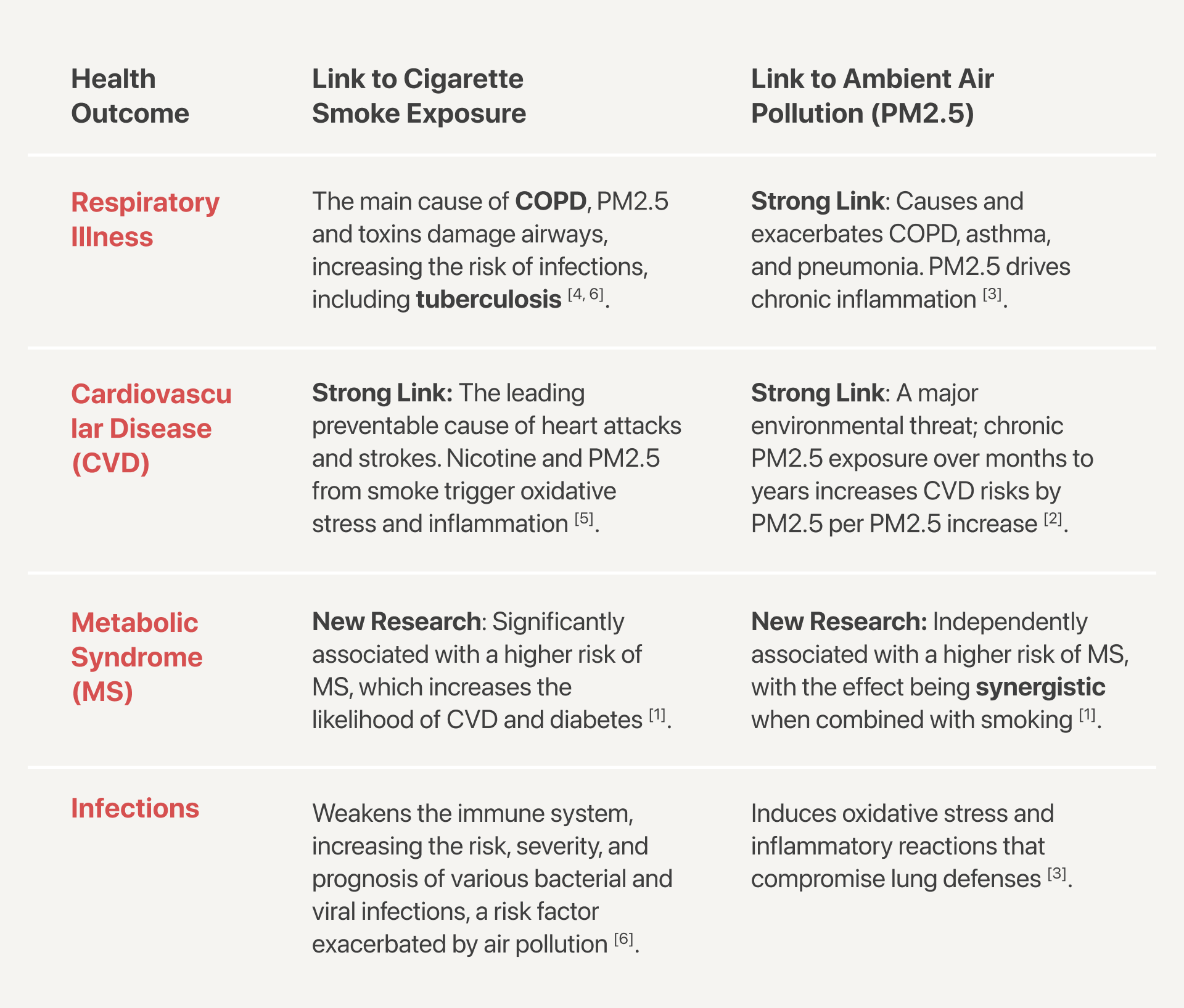LEARN / ARTICLE
How Cigarette Smoke and Air Pollution Create Double Hazard
How Cigarette Smoke and Air Pollution Create a Double Health Hazard
In the global fight for public health, two major environmental hazards, cigarette smoke and ambient air pollution, stand out as relentless aggressors. Both are prolific sources of harmful particulate matter (PM2.5) and toxic chemicals, and together, they represent a synergistic threat that drastically escalates the risk of life-threatening diseases for individuals across the globe.
A Cocktail of Toxins: Cigarettes and Air Quality
Current research consistently reinforces that a burning cigarette is a powerful point source of local air pollution. When ignited, tobacco smoke releases over 7,000 chemicals, with at least 250 identified as toxic or carcinogenic, including high concentrations of fine particulate matter (PM2.5) [4, 6].
The primary mechanism by which cigarette smoke and air pollution converge is the introduction of these ultra-fine particles into the body:
- Secondhand Smoke (SHS): This involuntary exposure delivers a chemical cocktail, with even brief exposure capable of inducing inflammatory and oxidative stress responses [6]. Nonsmokers exposed to SHS have approximately a 30% higher risk of developing coronary artery disease (CAD) compared to unexposed individuals [5].
- Ambient PM2.5: This particulate matter, derived from vehicle exhaust, power generation, and industry, is recognized globally as the largest environmental risk factor for public health. It travels deep into the lungs and enters the bloodstream, causing systemic inflammation and endothelial dysfunction [2, 3]. Chronic exposure to high ambient PM2.5 levels disproportionately impacts low- and middle-income nations [2].
The Overlap in Health Risks
The health dangers from both exposures are strikingly similar, as both introduce comparable harmful agents into the body. Recent studies confirm that the combination of these exposures leads to compounded health risks, particularly in the most prevalent chronic diseases.

When Two Pollutants Work Together
The greatest concern lies in the synergistic effect, where the combined impact of smoking and air pollution is greater than the sum of their individual effects.
A key 2024 study investigated this joint effect and confirmed that PM2.5 exposure and cigarette smoking were independently and jointly associated with a higher risk of Metabolic Syndrome (MS). Specifically, the group with the highest combined exposure (current smokers in the highest PM2.5 quartile) had the highest odds of developing MS, confirming that the two exposures compound the risk [1].
This finding underscores a critical public health reality: populations facing high ambient pollution, particularly in developing and highly urbanized regions, see the health risks of smoking severely amplified, demanding aggressive, parallel policy interventions.
Healthier Air Starts With All of Us
The dual threat of cigarettes and air pollution requires a unified approach to public health and environmental policy. Protecting human health means addressing all sources of harmful combustion from traffic and industry to the ubiquitous cigarette to secure a healthier, cleaner environment for all citizens.
Don’t let bad air affect your health and the people we care about, Clean Air Zone protects your healthy air inside!
Wanna make your Gym, Home, School, and Office to be part of Clean Air Zone?
Subscribe now with promo code : NAFASCAZ
Scientific Journal References
- Tsai, H-H., Tantoh, D. M., Lu, W. Y., Chen, C. Y., & Liaw, Y. P. (2024). Cigarette smoking and PM2.5 might jointly exacerbate the risk of metabolic syndrome. Frontiers in Public Health, 11. doi:10.3389/fpubh.2023.1234799
- Chauhan, A. J., & Johnston, D. (2020). Cardiopulmonary impact of particulate air pollution in high-risk populations: JACC state-of-the-art review. Journal of the American College of Cardiology, 76(22), 2649–2661. doi:10.1016/j.jacc.2020.10.020
- Gheorghe, E., & Ghiță, I. G. (2020). Environmental and health impacts of air pollution: A review. Frontiers in Public Health, 8, 14. doi:10.3389/fpubh.2020.00014
- World Health Organization (WHO) Study Group on Tobacco Product Regulation. (2020). Lung health, tobacco, and related products: gaps, challenges, new threats, and suggested research. Tobacco Control, 29(Suppl 1), s1–s11. doi:10.1136/tobaccocontrol-2020-055745
- Mallat, K., Soomro, M. H., Ali, W., Noreen, S., Khatoon, L., Kafle, B. S., ... & Zhang, C. (2023). Cigarette smoking and air pollution exposure and their effects on cardiovascular diseases. Frontiers in Public Health, 11. doi:10.3389/fpubh.2023.967047
- Tsai, K. W., Sun, C. Y., Lee, T. Y., Kuo, C. H., & Yang, S. F. (2020). Smoking increases the risk of infectious diseases: A narrative review. Clinical and Experimental Medicine, 20(4), 481–496. doi:10.1007/s11270-020-04664-9
